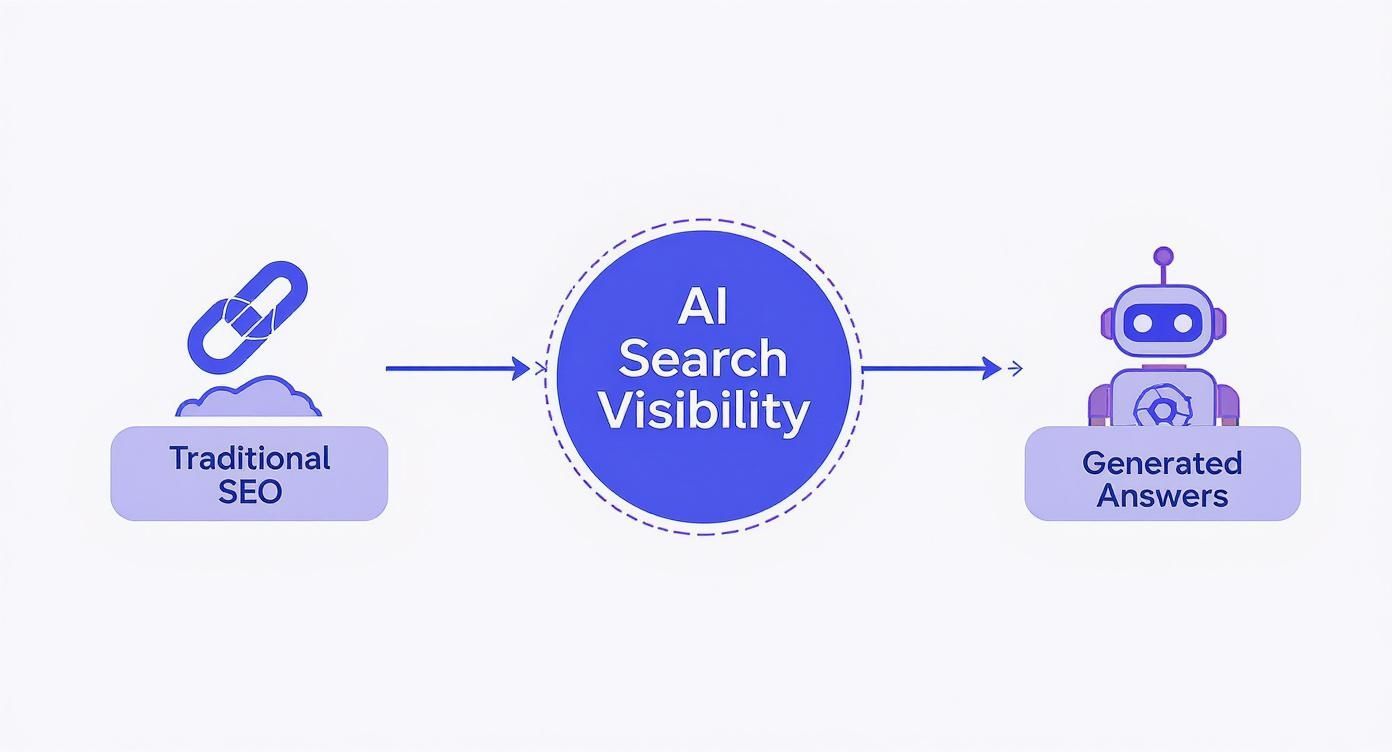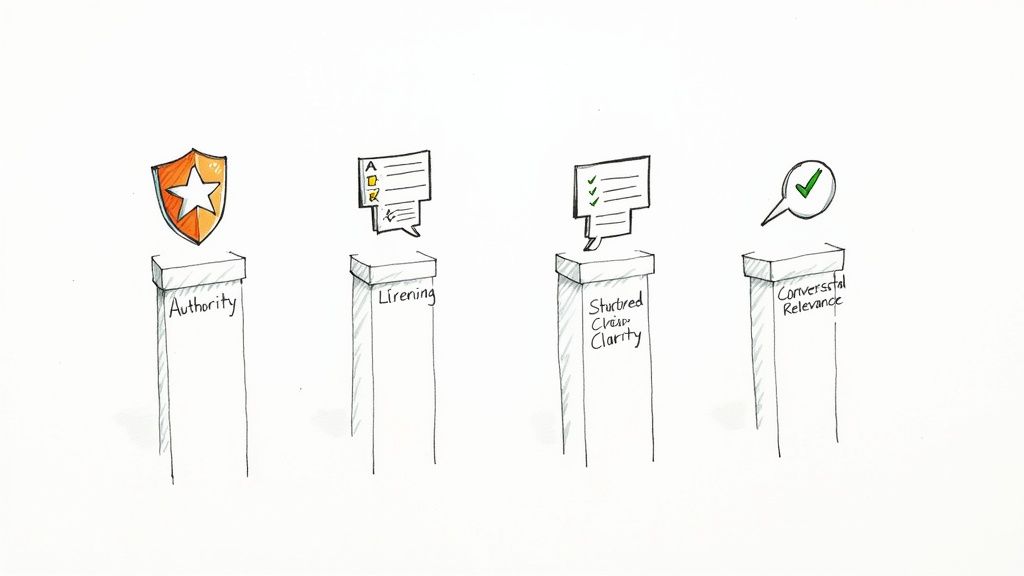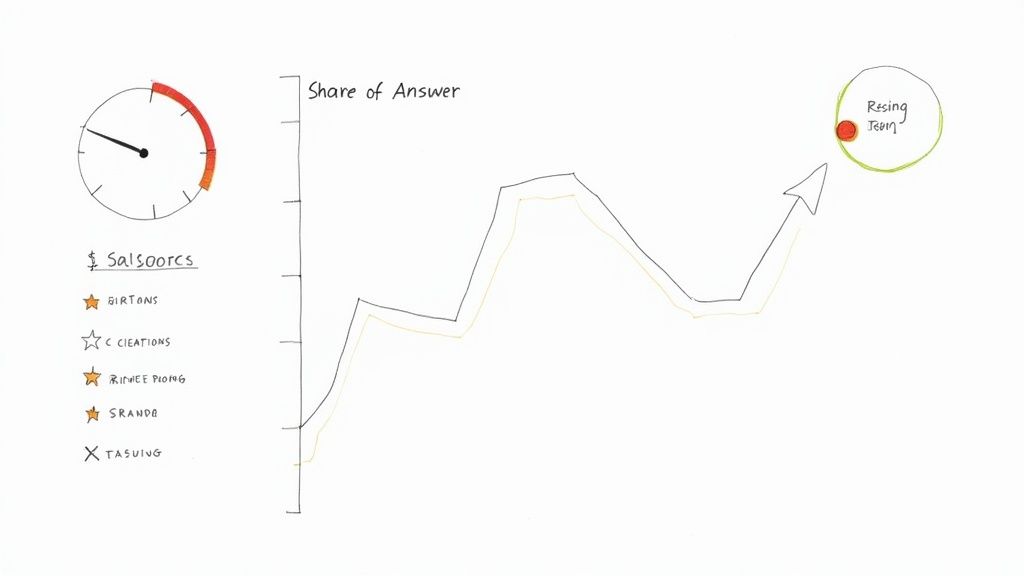Remember when the goal was getting your blue link on Google's first page? That era is over.
AI-powered answer engines like Perplexity and Google’s AI Overviews are the new front door to the internet. They deliver direct, synthesized answers, so users often don’t need to click through to any websites. This has created a new battlefield for AI search visibility—the only metric that matters when your goal is to get your brand’s expertise inside these generated answers.
If your content isn't cited, you're invisible.
Why Your Brand Is Disappearing from Search
Noticing a slow, creeping decline in traffic for keywords you once dominated? You’re not imagining it. Your audience is getting answers straight from an AI, and if your brand isn't cited as a source, you've vanished for a growing part of your market.
Visibility is no longer about ranking on page one.
It’s about being chosen by an AI model as a trustworthy source whose insights are worth weaving into a generated answer. This requires a fundamental shift in strategy. We have to move past chasing old-school keyword rankings and focus on how machines interpret and value our expertise.
This concept map shows how AI search visibility builds on traditional SEO but points to the new reality of generated answers.

Core SEO is still the foundation. But the path to the user now runs directly through an AI answer box, making direct citations the new prize.
The New Rules: Machine-Readability is Everything
Here’s the problem: an AI doesn’t "read" your website like a person. It parses it, breaking down your content into logical chunks it can analyze for authority. If your content is a mess or your most important points are buried in long-winded paragraphs, the AI moves on.
This guide provides a straightforward plan to overhaul your content strategy. The goal is simple: get your expertise featured, not forgotten.
We'll focus on three areas:
- Understanding the AI Shift: How answer engines change user habits and what that means for your traffic.
- Measuring What Matters: The new metrics, like Share of Answer, that are replacing outdated keyword tracking.
- Adapting Your Content: Actionable steps to make your content machine-readable and authoritative.
The challenge for marketers is making content so clear and well-structured that an AI can use it with total confidence. If your content isn’t aligned with what these models look for, it won't be included in an answer—even if it's perfectly "optimized" by old standards.
Think of a B2B SaaS company with a great blog post on "how to improve team productivity." In the old days, ranking #1 was the victory. Today, AI search visibility means having their specific five-step method cited directly in an AI's answer.
That citation is the new click. This is the new definition of success.
Traditional SEO vs. AI Search Visibility
The game has changed, and so have the metrics. What worked for the "10 blue links" era is becoming obsolete. Here’s how the core objectives are shifting.
| Metric | Traditional SEO (10 Blue Links) | AI Search Visibility (Generated Answers) |
|---|---|---|
| Primary Goal | Rank a URL in the top 10 search results. | Get your brand's expertise featured in a generated answer. |
| Key Metric | Keyword ranking position (#1, #2, etc.). | Share of Answer (how much of the answer uses your info). |
| User Interaction | User scans links, clicks through to your website. | User gets an immediate, direct answer within the AI. |
| Content Focus | Long-form content targeting a primary keyword. | Modular, structured content with clear, citable facts. |
| Success Signal | High click-through rate (CTR) from the results page. | Being cited as a source with a link back to your content. |
This table is a roadmap. The right column shows where the puck is going. While traditional SEO provides a necessary foundation, focusing solely on it means you're playing yesterday's game. To win now, you need to master the metrics of AI Search Visibility.
How AI Is Rewriting the Rules of Search

For years, the goal was simple: get clicks from a list of blue links. But that playbook is officially obsolete. Users now expect direct, synthesized answers from AI, and this shift is creating new winners and losers overnight.
While Google's dominance feels absolute, AI is creating the first real cracks in its armor. Bing, once a distant second, has clawed its way back to relevance by plugging ChatGPT directly into its search.
As of mid-2024, Google still handles a massive share of global search traffic. But in the U.S., Bing has climbed to over 9% market share, fueled almost entirely by its AI features, according to Statcounter data.
From Links to Direct Answers
The biggest change isn't the tech—it's user behavior. People are done sifting through pages of results to piece together an answer. They want it now, delivered in a clean, conversational format.
This change directly threatens your traffic, brand recognition, and lead flow. If your content isn't built for an AI to find, parse, and cite, you’re basically invisible. Improving your AI search visibility is no longer a "nice-to-have." It’s a core survival tactic.
To compete, you have to learn how to talk to these systems. Understanding how to structure information for them, like mastering AI prompts with prompt engineering, is quickly becoming a non-negotiable skill for marketers.
The Rise of Specialized Answer Engines
It's not just about Bing. A new breed of "answer engines" is emerging. Tools like Perplexity and Claude are built from the ground up to skip the traditional search results page entirely, providing direct, cited answers.
These platforms don't just find information; they synthesize it. They pull facts, figures, and steps from multiple sources to create a single, cohesive response. Your goal is to be one of those trusted sources.
This means adaptability is the most valuable SEO skill today. Here’s how this is playing out:
-
Case Study 1: The B2B Software Review Site. A popular tech blog saw its traffic for "best project management software" tank. They restructured their articles with clean comparison tables and explicit pros and cons for each tool. Almost immediately, they started appearing as a primary source in AI-generated summaries, reclaiming their authority.
-
Case Study 2: The E-commerce Retailer. An online store selling coffee gear created a guide on "how to descale a coffee machine" using a simple, numbered list. The format was perfect for AI. Now, their step-by-step process is frequently cited in answers, driving highly qualified traffic directly to their site.
The Four Pillars of Winning AI Visibility

Showing up in an AI-generated answer isn't about some clever hack. It’s about building a solid foundation based on four core principles. To improve your ai search visibility, you need to strengthen each one.
Pillar 1: Authority and Trust
AI models are designed to play it safe. They favor information from sources with a proven track record of credibility.
This is where traditional SEO signals still carry immense weight. A strong backlink profile from reputable sites, a history of creating in-depth content, and consistent topical coverage are non-negotiable. Authority isn't just about links, though. It's about depth. An AI is far more likely to trust a site with 50 detailed articles on project management than a generalist site that published a single post on the topic last year.
Pillar 2: Structured Clarity
Here's a critical distinction: AI models don't "read" your content. They parse it. They break your webpage down into logical, machine-readable chunks.
If your most important facts are buried inside a dense paragraph, the AI will likely skip them.
Your content has to be organized for a machine. This is the entire premise behind answer engine optimization.
Here’s how you create machine-friendly clarity:
- Use Clear Headings: Your H2s and H3s are a table of contents, telling the AI exactly what each section covers.
- Leverage Lists and Tables: Bullet points, numbered steps, and comparison tables are structured goldmines. They're easy for an AI to digest and are often lifted directly into answers.
- Implement Schema Markup: Schema is a label you add to your code that explicitly tells machines what your content is (e.g., this is a product, this is a review, this is an FAQ).
A financial services company wanted to become the source for the query "what is a Roth IRA." Instead of a long, meandering article, they built a page with an H2 for each key question, used a simple Q&A format, and included a clean comparison table showing a Roth IRA vs. a Traditional IRA. Because the data was so well-structured, AI models could easily parse it, and they quickly became a cited source.
Pillar 3: Factual Accuracy
AI systems constantly cross-reference information to verify what's true. Unsupported claims or outdated data are massive red flags that will get your content disqualified.
Every statistic, number, or key fact you present needs to be verifiable. Better yet, link it directly to the original source. An algorithm is fact-checking your content in real-time. Make it easy for the AI to confirm you're correct.
Pillar 4: Conversational Relevance
Finally, your content has to directly answer the questions your audience is actually asking. People don't talk to AI with stilted keywords; they use natural, conversational language. Your content needs to mirror that.
Instead of just targeting a keyword like "enterprise software pricing," create content that answers conversational queries, such as:
- "How much does enterprise software usually cost per user?"
- "What are the hidden fees in enterprise software contracts?"
By aligning your content strategy with these four pillars, you're not just optimizing a page—you're building a powerful foundation for earning citations and winning the battle for ai search visibility.
Measure What Matters: Your Share of the Answer

You can't improve what you don't measure. For years, SEOs have obsessed over keyword rankings, but that metric is quickly becoming a vanity number. When users get answers directly from an AI, your position on a results page means very little.
The new world of AI search visibility demands a different set of KPIs.
It's time to shift your focus from "where do I rank?" to "am I part of the answer?" This requires a new way of thinking, built around two core metrics that reflect your performance in this new landscape.
Introducing Share of Answer
The most critical new metric is Share of Answer. This KPI tells you how often your brand is cited as a source in AI-generated responses for your target topics. Think of it as the direct replacement for traditional keyword ranking.
Instead of tracking if your URL is #3, you track if your brand is mentioned 30% of the time an AI answers a question about your product category. This is a far more honest indicator of your authority. You can learn more about how this evolves from traditional metrics in our guide on share of voice measurement.
Tracking Citation Quality
The second metric is Citation Quality. It’s not enough to just get mentioned; you need to dig into how you’re being mentioned.
Citation Quality answers the tough questions: Is the AI presenting my information accurately? Is the sentiment positive? Is the link sending users to a high-intent page? A negative or misleading citation can be worse than no citation at all.
This new measurement framework is essential because the AI search market is exploding. The global AI search engine market was valued at USD 16.28 billion in 2024 and is projected to hit USD 50.88 billion by 2033, according to this market forecast on Grand View Research. This isn't just growth; it's a massive shift in user behavior.
Here’s how to start building your AI search visibility dashboard:
- Define Your Core Topics: Pinpoint the 10-15 key conversational questions a qualified customer would ask.
- Establish a Baseline: Manually check these queries in tools like Perplexity, ChatGPT, and Gemini. Document who gets cited and how.
- Use Specialized Tools: Manual tracking isn't scalable. Platforms like AI SEO Tracker automate this, monitoring your Share of Answer and Citation Quality over time.
- Correlate with Business Goals: Connect your AI visibility metrics back to what matters—brand mentions, referral traffic from AI sources, and lead quality.
This approach gives you a true picture of your performance in the AI era.
How Real Brands Win with AI SEO
Theory is great, but seeing how actual companies are adapting their strategies gives you a real blueprint. Improving your AI search visibility is about making smart, deliberate changes to your content.
Here are two realistic scenarios to show you what’s working right now.
B2B SaaS Regains Its How-To Authority
A mid-sized B2B SaaS company sells project management software. For years, their detailed "how-to" articles were their bread and butter, pulling in steady organic traffic. Suddenly, that traffic started to dip.
The problem wasn't a lack of expertise—it was a lack of structure. AI simply couldn't parse their long, narrative-style guides.
So, they rolled out a three-step fix:
- Restructured Content: They took their top 10 guides and rebuilt them. Instead of long paragraphs, they used clear, numbered step-by-step instructions under distinct H2 and H3 headings.
- Implemented FAQ Schema: At the end of each guide, they added a short FAQ section answering the three most common follow-up questions, then marked it up with
FAQPageschema. - Tracked "Share of Answer": They shifted their focus from keyword rankings to their "Share of Answer"—how often their brand was cited for their target queries.
The results? Within six weeks, their brand started showing up as the main source in AI answers. Their Share of Answer for critical "how-to" queries shot up from less than 5% to over 40%.
E-commerce Dominates "Best Product" Queries
Now, consider an e-commerce brand selling specialized hiking gear. People asking "best hiking boots for rocky trails" were getting AI-generated comparison lists that completely left them out. These zero-click searches were killing sales.
They realized AI models need structured, comparable data to build those lists. Their product descriptions were creative but weren't machine-readable.
They decided to feed the AI exactly what it needed: clean, comparable data.
Their strategy was all about data clarity:
- They built new pages comparing their top products head-to-head against competitors.
- Each page had a simple table with clear data points: weight, waterproofing rating, price, and best use case.
- They wrapped everything in
Productschema, making sure every key attribute was explicitly defined for the AI.
This shift got their brand consistently featured in AI-generated answers for "best of" queries. They also saw a jump in direct traffic from users clicking the source links inside the AI answers, proving high purchase intent. For a deeper dive, check out our guide on AI optimization for making products more visible. And to get ahead, explore advanced SEO Pro AI tools.
Actionable Next Steps to Win AI Visibility
The shift to AI answers brings up valid questions. The old rules of SEO are being rewritten. Here are straight answers to the questions we hear most often.
Does Traditional SEO Still Matter?
Yes, absolutely. Think of traditional SEO as the foundation of your house. AI models still lean heavily on established authority signals—high-quality backlinks, solid internal linking, and site speed—to figure out who to trust.
But a strong foundation isn’t enough. Traditional SEO gets your content considered; AI-specific optimizations get it chosen for the answer. You have to layer on conversational language, structured data, and machine-readable formatting.
The biggest mistake we see is assuming the old playbook will work. An AI can't cite what it can't parse. If your key insights are buried in long paragraphs, they might as well not exist.
What Is the Biggest Mistake Companies Make?
The single biggest mistake is waiting for organic traffic to drop before taking action. Too many brands are still glued to their traditional keyword ranking reports, but those are lagging indicators in an AI-first world.
By the time you see a significant drop in traffic, your competitors may have already cemented themselves as the go-to authority in AI models. You’ll be stuck playing catch-up.
The right move is to be proactive. You have to start tracking your AI search visibility now.
- Figure out your most important customer questions.
- Establish a baseline by asking those questions in Perplexity, Gemini, and ChatGPT. Document which brands get cited.
- Find your content gaps where competitors are featured and you aren’t. This becomes your priority list.
How Can I Start Tracking My AI Visibility Today?
You can start manually, right now. It takes less than 30 minutes to get a basic snapshot of where you stand.
Pick your top 5-10 most valuable customer questions. Go to an AI answer engine and ask a few variations. Document everything: Who gets cited? Are you mentioned? Is the information about you accurate? This simple exercise gives you a rough but valuable baseline.
Of course, manual tracking isn't a scalable solution. For consistent, automated monitoring, you'll need a dedicated tool. Specialized AI SEO platforms are built to track your presence in generative answers, showing you what content is working and where to focus. This is how you move from guessing to building a data-driven strategy.
Your Action Plan
Don't wait for your traffic to decline. Take these three steps this week:
- Identify your top 5 customer questions. Choose queries that signal high intent.
- Manually check them in 2-3 AI engines. See who is being cited today.
- Audit the top-cited content. Analyze its structure, clarity, and use of data. This is your new competitive benchmark.
Ready to stop guessing and start measuring what matters? The AI SEO Tracker platform shows you exactly where your brand appears in AI answers across ChatGPT, Gemini, and Perplexity. See what customers are asking, track your Share of Answer against competitors, and get a clear action plan to win more citations. Learn more and get started.

